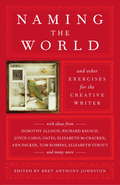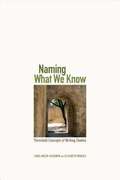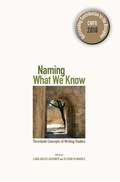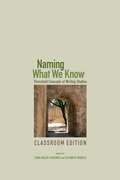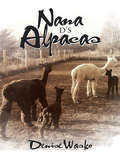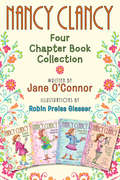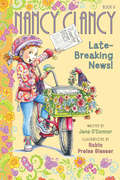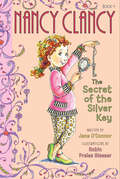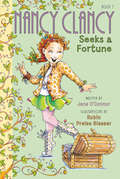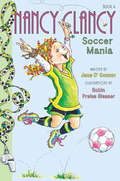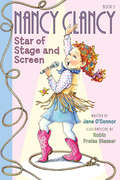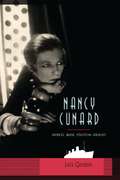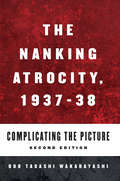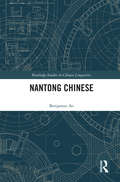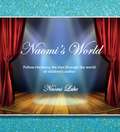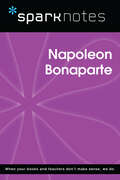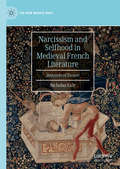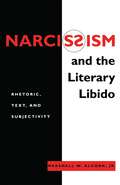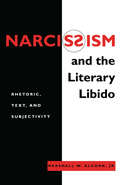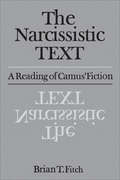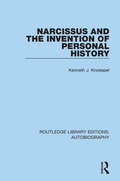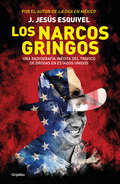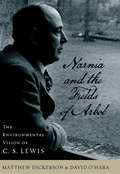- Table View
- List View
Naming the World: And Other Exercises for the Creative Writer
by Bret Anthony JohnstonYou already have the tools to become a gifted writer; what you need is the spark. Harvard creative writing professor and acclaimed author Bret Anthony Johnston brings you an irresistible interactive guide to the craft of narrative writing. From developing characters to building conflict, from mastering dialogue to setting the scene, Naming the World jump-starts your creativity with inspiring exercises that will have you scrambling for pen and paper. Every chapter is a master class with the country's most eminent authors, renowned editors, and dedicated teachers. * Infuse emotion into your fiction with three key strategies from Margot Livesey. * Christopher Castellani dumps the "write what you know" maxim and challenges you to really delve into the imagination. * A point-of-view drill from Susan Straight can be just the breakthrough you need to flesh out your story. * Jewell Parker Rhodes shares how good dialogue is not just about what is being said but about what is being left unsaid. Brimming with imaginative springboards and hands-on exercises, Naming the World has everything you need to become a stronger, more inventive writer. "A delicious book. Imagine yourself at a cocktail party crammed with literary lions. You have the chance to spend a few moments with each of them. Wit and wisdom abound." -Julia Cameron, author of The Artist's Way. "A highly useful and perceptive book. With charm and intelligence it touches on nearly every teachable aspect of the devilishly difficult art of writing." -Ethan Canin, professor of creative writing at the Iowa Writers Workshop, and author of Carry Me Across the Water. "These entertaining and useful exercises, intelligently organized, are a boon for both beginning and experienced writers." -Andrea Barrett, National Book Award--winning author of The Air We Breathe. "Forget about getting an MFA! For any writer struggling with his craft, here is the equivalent of a master class in writing by some of the best writer/teachers around." -Betsy Lerner, author of The Forest for the Trees: An Editor's Advice to Writers.
Naming What We Know
by Linda Adler-KassnerNaming What We Know examines the core principles of knowledge in the discipline of writing studies using the lens of "threshold concepts"--concepts that are critical for epistemological participation in a discipline. The first part of the book defines and describes thirty-seven threshold concepts of the discipline in entries written by some of the field's most active researchers and teachers, all of whom participated in a collaborative wiki discussion guided by the editors. These entries are clear and accessible, written for an audience of writing scholars, students, and colleagues in other disciplines and policy makers outside the academy. Contributors describe the conceptual background of the field and the principles that run throughout practice, whether in research, teaching, assessment, or public work around writing. Chapters in the second part of the book describe the benefits and challenges of using threshold concepts in specific sites--first-year writing programs, WAC/WID programs, writing centers, writing majors--and for professional development to present this framework in action.Naming What We Know opens a dialogue about the concepts that writing scholars and teachers agree are critical and about why those concepts should and do matter to people outside the field.
Naming What We Know: Threshold Concepts of Writing Studies
by Linda Adler-Kassner Elizabeth WardleNaming What We Know examines the core principles of knowledge in the discipline of writing studies using the lens of “threshold concepts”—concepts that are critical for epistemological participation in a discipline. The first part of the book defines and describes thirty-seven threshold concepts of the discipline in entries written by some of the field’s most active researchers and teachers, all of whom participated in a collaborative wiki discussion guided by the editors. These entries are clear and accessible, written for an audience of writing scholars, students, and colleagues in other disciplines and policy makers outside the academy. Contributors describe the conceptual background of the field and the principles that run throughout practice, whether in research, teaching, assessment, or public work around writing. Chapters in the second part of the book describe the benefits and challenges of using threshold concepts in specific sites—first-year writing programs, WAC/WID programs, writing centers, writing majors—and for professional development to present this framework in action. Naming What We Know opens a dialogue about the concepts that writing scholars and teachers agree are critical and about why those concepts should and do matter to people outside the field.
Naming What We Know, Classroom Edition: Threshold Concepts of Writing Studies
by edited by Linda Adler-Kassner, Elizabeth WardleNaming What We Know, Classroom Edition examines the core principles of knowledge in the discipline of writing studies, using the lens of “threshold concepts”—concepts that are critical for epistemological participation in a discipline. This edition focuses on the working definitions of thirty-seven threshold concepts that run throughout the research, teaching, assessment, and public work in writing studies. Developed from the highly regarded original edition in response to grassroots demand from teachers in writing programs around the United States and written by some of the field’s most active researchers and teachers, the classroom edition is clear and accessible for an audience of even first-year writing students.
Nana D's Alpacas
by Denise WaskoMs. Emily and her preschool classroom take an adventurous trip to learn more about alpacas. Come along on the journey to discover how curiosity and investigation lead to a love of outdoor learning.
Nancy Clancy: Four Chapter Book Collection
by Robin Preiss Glasser Jane O'ConnorSassy Fancy Nancy is now a detective! Kids who grew up with Jane O'Connor's Fancy Nancy picture books can spend some quality time with their BFF because Nancy Clancy is now starring in her own chapter books! This collection includes the first four Nancy Clancy mysteries.Nancy Clancy, Super Sleuth: When one of Nancy's classmate's most special possessions disappears from school, it's up to her to save the day. With the help of her friend Bree, she follows the clues to an unexpected source.Nancy Clancy, Secret Admirer: Nancy and Bree decide to play matchmaker, but nothing works out as planned. Will love conquer all in the end?Nancy Clancy Sees the Future: Nancy thinks she may be able to read the future . . . and all signs point to her being a true clairvoyant (that's fancy for a fortune-teller). Does Nancy really have special powers, or is it all just a coincidence?Nancy Clancy, the Secret of the Silver Key: Nancy buys an old desk at a tag sale and soon finds out that someone left behind a key. Nancy and Bree set out to unlock the secret of the silver key in the hopes of finding some treasure along the way. But unlocking the mystery soon proves to be more difficult than they had thought, and when the answer isn't what they had expected, Nancy and Bree learn there are some things that remain timeless forever.
Nancy Clancy, Late-Breaking News! (I Can Read! #8)
by Jane O'Connor Robin Preiss GlasserFrom New York Times bestselling team Jane O’Connor and Robin Preiss Glasser comes the eighth and final installment of the Fancy Nancy chapter book series: Nancy Clancy and the Late-Breaking News! <P><P>Nancy Clancy is working to be the star reporter of the Third Grade Gazette—that’s a fancy word for newspaper. <P>When the latest issue comes out, Nancy and Bree decide the articles just aren’t interesting enough and set out to find some really exciting news to report on. <P> But when Nancy overhears something she shouldn’t and the news gets out, she learns that a good reporter knows when to keep things confidential and may even get some surprising and unexpected news herself.
Nancy Clancy, Secret of the Silver Key (I Can Read! #4)
by Jane O'Connor Robin Preiss Glasser<P>Join Nancy Clancy in New York Times bestselling team Jane O'Connor and Robin Preiss Glasser's fourth Nancy Clancy chapter book about the past, present, and future! Nancy and her best friend, Bree, must go back in time to solve their latest mystery. <P>While Nancy's class learns about time capsules in school, another relic from the past pops up in the present. Nancy buys an old desk at a tag sale and soon finds out that someone left behind a key. In the perfect follow-up to Nancy Clancy, Super Sleuth; Nancy Clancy, Secret Admirer; and Nancy Clancy Sees the Future, Nancy and Bree set out to unlock the secret of the silver key in the hopes of finding some treasure along the way. <P>But unlocking the mystery soon proves to be more difficult than they had thought, and when the answer isn't what they had expected, Nancy and Bree learn there are some things that remain timeless forever. Fans of Fancy Nancy will love joining Nancy Clancy in the latest edition to the chapter book series. The central theme of all the Nancy Clancy books shines through, showing the power of positive thinking and the will to never give up.
Nancy Clancy Seeks a Fortune (I Can Read! #7)
by Robin Preiss Glasser Carolyn Bracken Jane O'ConnorNancy Clancy learns all about starting a business and making a fortune in the seventh chapter book in the Nancy Clancy chapter book series by New York Times bestselling team Jane O'Connor and Robin Preiss Glasser! <P><P>How great would it be to be wealthy--that's elegant for rich. Nancy Clancy sure thinks so, and with the help of her best friend, Bree, she sets out to make a fortune one way or another. <P>But when things don't go as planned, Nancy learns something even more valuable--some of the best things in life are free.
Nancy Clancy Sees the Future (I Can Read! #3)
by Jane O'ConnorNancy Clancy is back in New York Times bestselling team Jane O'Connor and Robin Preiss Glasser's third Fancy Nancy chapter book, Nancy Clancy Sees the Future! Nancy thinks she may be able to read the future . . . and all signs point to her being a true clairvoyant--that's fancy for fortune-teller. <P><P>In this perfect follow-up to Nancy Clancy, Super Sleuth and Nancy Clancy, Secret Admirer, Nancy tries her hand at fortune-telling but quickly learns it's a bit more complicated than she thought. Does Nancy really have special powers, or is it all just a coincidence? <P>Fancy Nancy fans will love joining Nancy Clancy in the latest edition to the chapter book series. The central theme of all the Nancy Clancy books shines through, showing the power of positive thinking.
Nancy Clancy, Soccer Mania (I Can Read! #6)
by Robin Preiss Glasser Jane O'ConnorNancy Clancy takes the field in New York Times bestselling team Jane O'Connor and Robin Preiss Glasser's sixth Nancy Clancy chapter book. <P><P>Normally Nancy doesn't like dressing like everyone else. But wearing a soccer team uniform--well, that's different. Nancy adores being on the Green Goblins--she loves cheering for her teammates, sharing refreshments, and painting her fingernails bright green before every game. <P>If only she wasn't cursed with slow legs! All Nancy wants is to be mediocre--or maybe even a little better than average. Will she reach her goal? <P> Here's a brand-new chapter book with plenty of humor and sports action, written expressly for kids like Nancy who aren't the star of their team. Fans of Fancy Nancy will love joining Nancy Clancy in the latest edition to the chapter book series!
Nancy Clancy, Star of Stage and Screen (I Can Read! #5)
by Robin Preiss Glasser Jane O'ConnorNancy Clancy is ready for her close-up in the fifth chapter book in the Nancy Clancy chapter book series by the New York Times bestselling team of Jane O'Connor and Robin Preiss Glasser.It's <P><P>Nancy's time to shine as she takes center stage in the school play! There's no way Nancy will get stuck in the chorus again this year--she's been practicing guitar for months and her audition was superb. So when Nancy gets a callback, she's overwhelmed with joy! <P>But after Nancy's performance during the play is captured on a video that gets posted on YouTube, it seems her stardom has gone viral. Will Nancy's humiliation get the best of her, or will she find a way to embrace her newfound fame? <P>Fans of Nancy Clancy will enjoy watching Nancy sparkle in the spotlight in her latest chapter book. The central theme of all the Nancy Clancy books shines through, showing the power of positive thinking.
Nancy Cunard: Heiress, Muse, Political Idealist
by Lois GordonLois Gordon's absorbing biography tells the story of a writer, activist, and cultural icon who embodied the dazzling energy and tumultuous spirit of her age, and whom William Carlos Williams once called "one of the major phenomena of history."Nancy Cunard (1896-1965) led a life that surpasses Hollywood fantasy. The only child of an English baronet (and heir to the Cunard shipping fortune) and an American beauty, Cunard abandoned the world of a celebrated socialite and Jazz Age icon to pursue a lifelong battle against social injustice as a wartime journalist, humanitarian aid worker, and civil rights champion.Cunard fought fascism on the battlefields of Spain and reported firsthand on the atrocities of the French concentration camps. Intelligent and beautiful, she romanced the great writers of her era, including three Nobel Prize winners, and was the inspiration for characters in the works of Ezra Pound, T. S. Eliot, Aldous Huxley, Pablo Neruda, Samuel Beckett, and Ernest Hemingway, among others. Cunard was also a prolific poet, publisher, and translator and, after falling in love with a black American jazz pianist, became deeply committed to fighting for black rights. She edited the controversial anthology Negro, the first comprehensive study of the achievement and plight of blacks around the world. Her contributors included Langston Hughes, W. E. B. Du Bois, and Zora Neale Hurston, among scores of others.Cunard's personal life was as complex as her public persona. Her involvement with the civil rights movement led her to be ridiculed and rejected by both family and friends. Throughout her life, she was plagued by insecurities and suffered a series of breakdowns, struggling with a sense of guilt over her promiscuous behavior and her ability to survive so much war and tragedy. Yet Cunard's writings also reveal an immense kindness and wit, as well as her renowned, often flamboyant defiance of prejudiced social conventions.Drawing on diaries, correspondence, historical accounts, and the remembrances of others, Lois Gordon revisits the major movements of the first half of the twentieth century through the life of a truly gifted and extraordinary woman. She also returns Nancy Cunard to her rightful place as a major figure in the historical, social, and artistic events of a critical era.
Nancy Hale: On the Life and Work of a Lost American Master (Unsung Masters Series)
by Phong Nguyen Dan ChaonNancy Hale (1908-1988) began publishing short stories in The New Yorker in the 1930s, and her career spanned the next fifty years. Her novel The Prodigal Women was a runaway bestseller in 1942. Yet today Nancy Hale is nearly forgotten. This collection of seven short stories and numerous critical essays seeks to bring Hale's work to today's readers. Though she writes about an effete group of characters - wealthy, artistic women from New England or Virginia - Hale captures the joys and sadness of the human condition.
The Nanking Atrocity, 1937-1938: Complicating the Picture
by Bob Tadashi WakabayashiFirst published in 2007, The Nanking Atrocity remains an essential resource for understanding the massacre committed by Japanese soldiers in Nanking, China during the winter of 1937-38. Through a series of deeply considered and empirically rigorous essays, it provides a far more complex and nuanced perspective than that found in works like Iris Chang's bestselling The Rape of Nanking. It systematically reveals the flaws and exaggerations in Chang's book while deflating the self-exculpatory narratives that persist in Japan even today. This second edition includes an extensive new introduction by the editor reflecting on the historiographical developments of the last decade, in advance of the 80th anniversary of the massacre.
Nantong Chinese (Routledge Studies in Chinese Linguistics)
by Benjamin AoNantong Chinese is an in-depth account of an interesting and endangered Sinitic language spoken in Nantong, China, in an area in the Northern Yangtze River Delta about 800 square kilometers in size and 105 kilometers northwest of the city of Shanghai. The Chinese language consists of several hundred local varieties known as Sinitic languages or Chinese dialects, each representing a unique linguistic system. This book offers a comprehensive and systematic insight into one such system that is even more complex and more interesting than standard Mandarin. The unique vocalization and other linguistic features of Nantong Chinese make it unintelligible to most Chinese people. All the important linguistic aspects of Nantong Chinese are covered, including its phonetic, lexical, morphological and syntactic subsystems. Nantong Chinese will be of interest to professionals and students in linguistics worldwide.
Naomi's World: Follow Harmony the Hen through the world of children’s author Naomi Lake
by Naomi LakeThis book, brought to you by Carers WA, dives into the challenges young people may have with disabilities. No matter what you face in life or the challenges it brings you, stay strong and never give up on your dreams. Naomi is a children's author in Albany, Western Australia who has published two books about Harmony the Hen. She is also an ambassador for Down Syndrome WA. "Being a role model for others and encouraging children to read and write is a passion of mine because it has opened up the world for me. I love learning and trying new things whenever I have the opportunity. You just have to go out to explore the world because the world won’t come to you.”
Napoleon Bonaparte (SparkNotes Biography Guide)
by SparkNotesNapoleon Bonaparte (SparkNotes Biography Guide) Making the reading experience fun! SparkNotes Biography Guides examine the lives of historical luminaries, from Alexander the Great to Virginia Woolf. Each biography guide includes:An examination of the historical context in which the person lived A summary of the person&’s life and achievements A glossary of important terms, people, and events An in-depth look at the key epochs in the person&’s career Study questions and essay topics A review test Suggestions for further reading Whether you&’re a student of history or just a student cramming for a history exam, SparkNotes Biography guides are a reliable, thorough, and readable resource.
Narcissism and Selfhood in Medieval French Literature: Wounds of Desire (The New Middle Ages)
by Nicholas EalyThis book offers analyses of texts from medieval France influenced by Ovid’s myth of Narcissus including the Lay of Narcissus, Alain de Lille’s Plaint of Nature, René d’Anjou’s Love-Smitten Heart, Chrétien de Troyes’s Story of the Grail and Guillaume de Machaut’s Fountain of Love. Together, these texts form a corpus exploring human selfhood as wounded and undone by desire. Emerging in the twelfth century in Western Europe, this discourse of the wounded self has survived with ever-increasing importance, informing contemporary methods of theoretical inquiry into mourning, melancholy, trauma and testimony. Taking its cue from the moment Narcissus bruises himself upon learning he cannot receive the love he wants from his reflection, this book argues that the construct of the wounded self emphasizes fantasy over reality, and that only through the world of the imagination—of literature itself—can our narcissistic injuries seemingly be healed and desire fulfilled.
Narcissism and the Literary Libido: Rhetoric, Text, and Subjectivity
by Marshall W. Alcorn, Jr.What is it that makes language powerful? This book uses the psychoanalytic concepts of narcissism and libidinal investment to explain how rhetoric compels us and how it can effect change. The works of Joseph Conrad, James Baldwin, Michael Foucault, Jacques Derrida, Arthur Miller, D.H. Lawrence, Ben Jonson, George Orwell, and others are the basis of this thoughtful exploration of the relationship between language and subject. Bringing together ideas from Freudian, post- Freudian, Lacanian, and post-structuralist schools, Alcorn investigates the power of the text that underlies the reader response approach to literature in a strikingly new way. He shows how the production of literary texts begins and ends with narcissistic self-love, and also shows how the reader's interest in these texts is directed by libidinal investment.Psychoanalysts, psychologists, and lovers of literature will enjoy Alcorn's diverse and far-reaching insights into classic and contemporary writers and thinkers.
Narcissism and the Literary Libido: Rhetoric, Text, and Subjectivity (Literature And Psychoanalysis Ser. #6)
by Marshall W. Jr.What is it that makes language powerful? This book uses the psychoanalytic concepts of narcissism and libidinal investment to explain how rhetoric compels us and how it can effect change. The works of Joseph Conrad, James Baldwin, Michael Foucault, Jacques Derrida, Arthur Miller, D.H. Lawrence, Ben Jonson, George Orwell, and others are the basis of this thoughtful exploration of the relationship between language and subject. Bringing together ideas from Freudian, post- Freudian, Lacanian, and post-structuralist schools, Alcorn investigates the power of the text that underlies the reader response approach to literature in a strikingly new way. He shows how the production of literary texts begins and ends with narcissistic self-love, and also shows how the reader's interest in these texts is directed by libidinal investment.Psychoanalysts, psychologists, and lovers of literature will enjoy Alcorn's diverse and far-reaching insights into classic and contemporary writers and thinkers.
The Narcissistic Text: A Reading of Camus' Fiction
by Brian FitchCritics, theologians, philosophers, and psychoanalysts have written several thousand books, theses, and articles about Camus' fiction. His first published novel, L'Etranger, had a unique impact on a whole generation of readers, and is other fiction, although not as well known, has also been influential. However, Camus' fiction so far has not been judged by contemporary critical methods, and 'inter-textuality,' or the study of the interrelationship between Camus' own texts, has not been examined. The Narcissistic Text: A Reading of Camus' Fiction is the first book devoted to the whole of Camus' fiction to adopt this approach. Brian Fitch uses the critical tools elaborated in the writings of such French formalists as Barthes, Ricardou, and Todorov and draws upon the hermeneutic theory of literature developed by Gadamer and Ricoeur. As a result, the self-generating word-play or linguistic narcissism of 'Jonas' and the textual narcissism of La Peste are seen to give way, in L'Etranger, to a situation where the hermeneutic circle is itself contained within the circularity of autoreprésentation. As for the narcissism of La Chute, it concerns the reader himself, since what the text provides is a model of the hermeneutic process. Fitch thus demonstrates that Camus' fiction occupies a significant place in modern literature. This volume will be of particular interest to those involved in Camus studies or concerned with contemporary critical methodology and literary theory.
Narcissus and the Invention of Personal History (Routledge Library Editions: Autobiography #3)
by Kenneth J. KnoespelOriginally published in 1985. This investigation of Ovid’s fable takes a different tack to previous studies of the love lyric or the themes but looks at the creation of narrative strategies to explain Narcissus’ experience. The story has always been understood as literally impossible but invites readers to ask what is meant by the puzzling tale of deception and death. The limits placed on the fable by the commentaries of the medieval period allow us to appreciate the narrative expansion of the fable in twelfth and thirteenth-century poetry. Themes in this book are the way the fable is used as a means for knowledge of physical nature and the development of science; the importance of language in the fable and in its settings when rewritten in other texts, and psychoanalytic aspects of Echo and Narcissus. The fable has the capacity to represent mental life and psychological crisis within other narratives and this is also an important discussion point, based around the medieval text Roman de la Rose. The book also considers the wider Metamorphoses and Ovid’s importance for literature.
Los narcos gringos: Una radiografía inédita del tráfico de drogas en Estados Unidos
by J. Jesús EsquivelJ. Jesús Esquivel, autor de La D.E.A. en México, ha conseguido develar los entresijos del narcotráfico en Estados Unidos al sumergirse en la lectura de incontables expedientes judiciales, además de entrevistar a informantes clave.De San Francisco a Nueva York y de la línea divisoria hasta Chicago, Los narcos gringos describe con minucioso detalle los ingeniosos trucos de que se valen los brokers, los artífices del tráfico de estupefacientes, para llevar sus mercancías al interior de la Unión Americana y lavar el producto de su labor ilícita que hacen llegar a los cárteles mexicanos, el verdadero poder de la ecuación.A lo largo de la frontera entre México y Estados Unidos, una de las más extensas y complejas del mundo, tiene lugar uno de los comercios más perniciosos, aunque con implicaciones desiguales para una y otra nación: mientras de un lado se queda la sangre y la violencia, en el otro imperan la logística, los prejuicios raciales y la insaciable avidez de los consumidores; todo envuelto por un manto de corrupción .Relatos y retratos insólitos -algunos dignos de llegar a las pantallas cinematográficas, como el del inolvidable Don Henry Ford Jr.- desfilan por estas páginas para cuestionar mitos como la despenalización y el perdón presidencial a delincuentes, presentando en cambio un panorama demoledor sobre la adicción y el alcance de los intereses que buscan satisfacerla. Los narcos gringos no usan camisas de seda italiana o botas de pieles de animales exóticos, tampoco gruesas cadenas de oro y mucho menos relojes caros con incrustaciones de diamantes. El prototipo del narco gringo es una persona común y corriente que viste un pantalón de mezclilla, camisa o camiseta, que no usa anillos ni conduce autos caros.
Narnia and the Fields of Arbol: The Environmental Vision of C.S. Lewis (Culture of the Land #Cull)
by Matthew Dickerson David O'HaraAn exploration of the Chronicles of Narnia and the Space Trilogy that &“enriches our understanding of how to care for our world&” (Alan Jacobs, author of Breaking Bread with the Dead). In Narnia and the Fields of Arbol: The Environmental Vision of C. S. Lewis, authors Matthew Dickerson and David O&’Hara illuminate an important yet overlooked aspect of the author&’s visionary work. They go beyond traditional theological discussions of Lewis&’s writing to investigate themes of sustainability, stewardship of natural resources, and humanity&’s relationship to wilderness. The authors examine the environmental and ecological underpinnings of Lewis&’s work by exploring his best-known works of fantasy, including the seven books of the Chronicles of Narnia and the three novels collectively referred to as the Space Trilogy. Taken together, these works reveal Lewis&’s enduring environmental concerns, and Dickerson and O&’Hara offer a new understanding of his pioneering style of fiction. Narnia and the Fields of Arbol, the first book-length work on the subject, finds the author&’s legacy to have as much in common with the agrarian environmentalism of Wendell Berry as it does with the fantasy of J. R. R. Tolkien. In an era of increasing concern about deforestation, climate change, and other environmental issues, Lewis&’s work remains as pertinent as ever. The widespread adaption of his work in film lends credence to the author&’s staying power as an influential voice in both fantastical fiction and environmental literature. With Narnia and the Fields of Arbol, Dickerson and O'Hara have written a timely work of scholarship that offers a fresh perspective on one of the most celebrated authors in literary history. &“Both revelatory and a pleasure to read.&” —Robert Siegel, award-winning author of The Whalesong Trilogy
